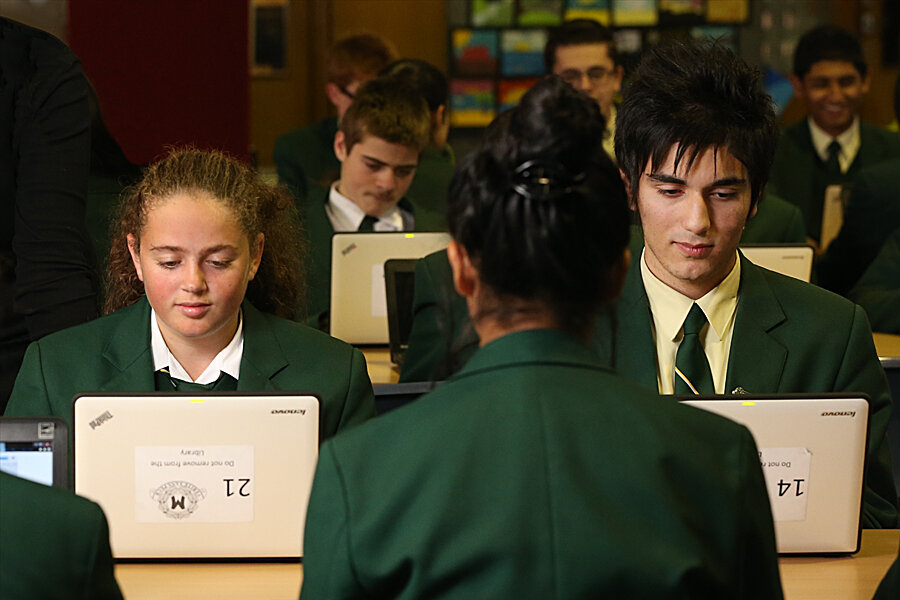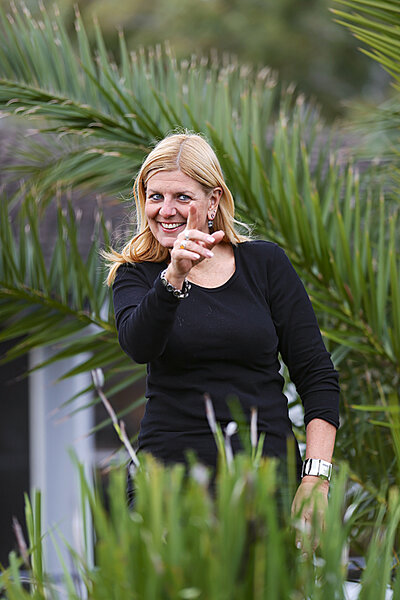Global education lessons: Australia teaches to test – a better test
Loading...
| Sydney, Australia; and New york
Alice Leung has been teaching science in the New South Wales public school system for six years, mostly trying to figure out ways to make herself redundant. "In the end," Ms. Leung believes, "good teachers build up the students so that they can be independent learners and eventually don't need you."
For that to happen, Leung needs to know the strengths and weakness of her students, a diverse group of seventh- through 12th-graders at Merrylands High School in Sydney's western suburbs. For this, she relies on a battery of techniques, ranging from quizzes designed to tell her students' starting point to mind-mapping exercises, games, brainstorming sessions, traditional tests, and tasks on online platforms.
Leung's classroom exemplifies a trend earning Australia accolades from international education experts: testing that promotes effective learning and teaching. This ranges from classroom tests like Leung's to certification tests administered at a statewide level. Here, as in the United States, teachers may find themselves teaching to such external tests; the difference is that the quality of those assessments is much higher than the multiple-choice format the US favors.
Ironically, Australia has recently introduced an additional national layer of assessments with the nationwide standardized testing and curricula that critics worry is a step toward a failed US model.
As the US prepares to roll out testing pegged to the new Common Core State Standards, it behooves American educators to listen in on Australian debate pitting well-established state exams against newer federal tests.
Introduced in 2008, Australia's National Assessment Program – or NAPLAN – tests literacy and numeracy skills through multiple-choice and short-answer questions. Students in Grades 3, 5, 7, and 9 are required to take it, and the results for individual school performance are published on My School, a public website.
Critics argue that the content is too narrow and the stakes too high. Since NAPLAN scores appear as the only measure of school and teacher performance, they say, teaching to this test has taken precedence over education strategies that encourage exploration, creative thinking, and analysis. They also point out that NAPLAN has not been around long enough to take credit for Australia's solid performance on Program for International Student Assessment tests. In 2009, the nation's mean scores on the tests ranked the country 9th in reading, 10th in science, and 15th in math (contrasted with the US rankings of 14th, 20th, and 30th, respectively). Federal policymakers hope NAPLAN will raise these scores further, while some critics refer to NAPLAN as "napalm.''
Liliana Mularczyk, principal of Merrylands and president of the NSW Secondary Principals' Council, expresses a less incendiary but no less critical view: "What you get from NAPLAN is a tiny sliver of a student's ability. You need to look at the whole person's learning level at different times, not just based on 40 questions."
By contrast, she and others point out, assessments like the Australian high school certification exams that students in most states take at the conclusion of Grade 12 measure a range of skills, abilities, and knowledge.
These exams are pegged to standards and curricula, which, like the examinations themselves, are formulated at the state level through an extensive and collaborative process that involves teachers, school administrators, and education experts.
When they sit for these state exams, students choose among 20 to 30 subjects, and "there are different approaches for different subjects," says Kevin Donnelly, a retired English teacher and founder of Education Standards Institute, a Melbourne think tank. "Here in Victoria," he explains, "some science exams might have a section with short answers and multiple choice," but most of the subjects require students to write essays. In the case of dance or music, they must perform; for visual arts they submit a portfolio.
Students also present a portfolio of research projects, science experiments, and in-school assessments that are considered alongside the exam results.
In many ways, this certification process resembles a cross between the International Baccalaureate and Advanced Placement. Like them, it includes an elaborate training and supervision system that ensures consistency in exam grading. This, in turn, steeps participating teachers – most at some point take part – in the state's standards and curriculum choices. This spills over into the classroom, helping to align teachers' approach to grading throughout the year, according to outside observers.
In radical contrast to the US, the state exams are then made available – students turn in their answers, but can leave clutching the sheet of questions. Also, anyone can access descriptions of the information and analysis expected in each answer, the grading guidelines, as well as sample answers and how these are ranked. This helps teachers understand the degree of critical thinking, factual knowledge, and communication skills their students need to succeed.
Leung, for example, uploads selections of past exams onto Edmodo, an online platform that allows her to collect data on what her students know and what gaps she needs to fill. It also allows students, with Leung's guidance, to give each other feedback as they would in a workshop.
Learning to evaluate others' work ultimately teaches them to look at their own work critically, bringing Leung one step closer to her goal of one day releasing students from her classroom with the skills to embark on a lifetime of learning.






